Protecting the precious environment
Pollution prevention and consideration for the local environment
Upon the development of condominiums, we give consideration to environmental pollution, noise, vibration, etc. and proactively propose the development of green areas.
Response to soil contamination (brownfield redevelopment)
In the acquisition of land, the Haseko Group investigates the usage history and conducts soil surveys by third-party specialists if there is any doubt about soil contamination.
When soil contamination is confirmed, based on the survey results, we consider costs, scheduling, and procedures, which include the cancellation of designations of areas that require measures and of designations of areas that require notification for any intended change in characteristic s in accordance with the Soil Contamination Countermeasures Act and other relevant laws and regulations. We then choose the most appropriate method for dealing with the contamination backed by our abundant experience. We take measures to prevent the spread of contamination, including excavation and removal or containment of pollutants.
Some of the contaminated soil which is excavated and removed is transported to cement works and other facilities conforming to relevant laws and regulations, and recycled as raw materials.
General waste soil resulting from excavation work at construction sites is disposed appropriately in accordance with relevant laws and regulations.
Construction site effluent quality management
For each construction site, Haseko Corporation establishes effluent plans after confirming relevant laws and regulations for the area.
It thoroughly manages the quality of construction site effluent using the Company’s own environmental law and regulation check sheet.
Management status is confirmed via an environmental patrol by a specialist division, and no issues have arisen to date.
Consideration for the Local Environment
When constructing new condominiums or renovating existing properties, the Haseko Group makes efforts to give consideration to the local environment such as using low-vibration and low-noise construction vehicles and machinery.
At some construction work sites, we have taken measures to minimize the impact on the surrounding area such as intermittently cleaning up the surrounding area, installing soundproof sheets on top of temporary enclosures, and taking measures to prevent noise during pile head processing.

Consideration for Biodiversity
Obtained Certification for Natural Symbiosis Site from the Ministry of the Environment
Registered as an OECM in the international database
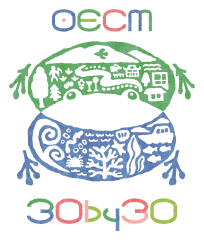
Haseko Corporation applied for and received certification from the Ministry of the Environment, designating Haseko Technical Center as a Natural Symbiosis Site (October 6, 2023), and has become one of the first 159 Japanese sites that have been designated as OECM* (August 22, 2024).
The 30by30 target, which aims to effectively protect or conserve at least 30% of land and sea areas as healthy ecosystems by 2030, has been set as a global biodiversity goal, and in Japan, the Ministry of the Environment certifies areas that protect biodiversity as Natural Symbiosis Sites. Apart from government-designated protected areas, certified Natural Symbiosis Sites are registered as OECMs.
The Haseko Group will further enhance its consideration for biodiversity and contribute to the achievement of Japan’s 30by30 target.
*OECM: An abbreviation for Other Effective area-based Conservation Measures, which refers to sites other than protected areas that protect biodiversity.


OECM site certificate award ceremony
Acquired ABINC Business Site Certification

The Association for Business Innovation in harmony with Nature and Community (ABINC) evaluates and certifies the biodiversity-conscious development, management, use, etc. of green areas in companies’ facilities (e.g., factories, office buildings, commercial facilities, condominiums) under its ABINC Business Site Certification (ABINC Certification), with the aim of promoting harmony between nature and people in corporate activities.
In fiscal 2023, five of the properties designed and constructed by Haseko obtained ABINC Certification. Amid the growing social interest in biodiversity consideration, we will contribute toward the improvement of the natural environment in cities by making proposals that take biodiversity into consideration.
Construciton of condominiums that take biodiversity (Japanese Only)
Example: Creating verdant spaces that harmonize with the environment

Premist Fujigaoka Nagoya-shi, Aichi

Premist Fujigaoka, a 360-unit condominium situated a 12-minute walk from Fujigaoka station on the Higashiyama subway line, was established on the site of a facility that has become cherished as a local hub for the community.
The area is wreathed in lush greenery that changes with the seasons all year round, bringing a sense of continuity.
We created a landscape that symbolically honors the memories of the district by preserving the two beloved Yuri-no-ki tulip trees that stand at over 10 meters tall. With over 2,000 m2 of green space, one never feels far from nature, and daily activities are infused with freshness. Being mindful of the natural network of wildlife native to the eastern Owari hills in neighboring areas, we have planted Shide-kobushi magnolia and other native species, fruiting trees such as Nanami-no-ki and Japanese snowbell to attract birds, and Fujibakama and Medohagi plants to attract butterflies.

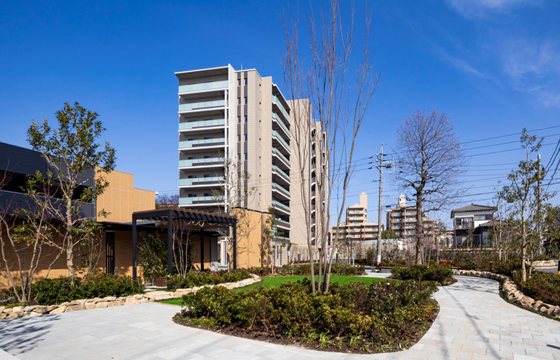
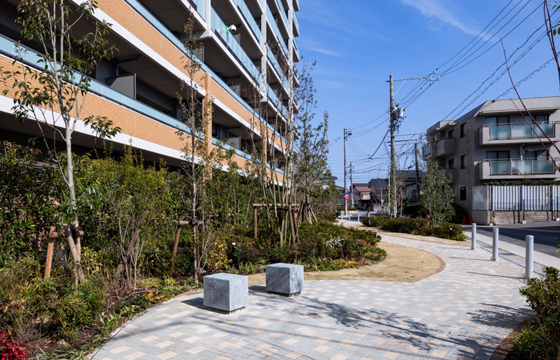

Proud City Toyota Tamadaira-no-Mori Hino-shi, Tokyo
The Tamadaira apartment complex is situated in Hino-shi in western Tokyo, on the terrace of the Asa River tributary of Tama River. Proud City Toyota Tamadaira-no-Mori was designed to preserve the large trees and the forest on the river terrace that have been nurtured for over 60 years since the construction of the original housing complex that stood on the site.
The site incorporates around 50 of the large trees in combination with around 350 medium-sized trees, largely common to the Tama region, creating a forested environment.
At the center of the complex is the “Timber House,” a common building constructed of wood. In addition, there are variety of zones for relaxing in the forest, such as the meadow-like “Hinata Field,” the “Forest Dining Table” area, which is equipped with a pizza oven, and “Fabre’s Garden” where one can spend time among living creatures. Strolling through the publicly-accessible “Green Corridor” that connects these areas to the greenery outside the premises takes one on a “sequential walk through the forest.” Whether walking through the garden and forested areas within the property, or strolling to a different green space, residents are able to enjoy the faces of the seasons in their daily lives and experience “living with the forest”.
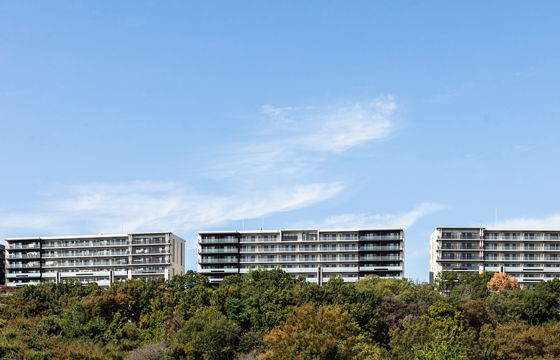
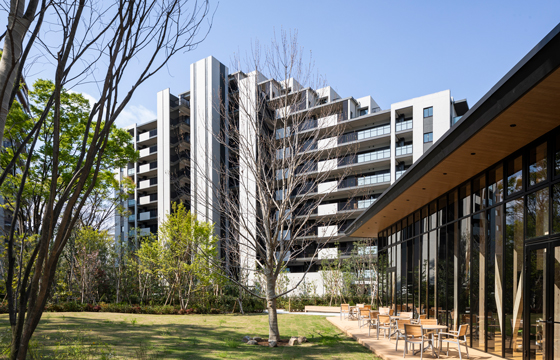
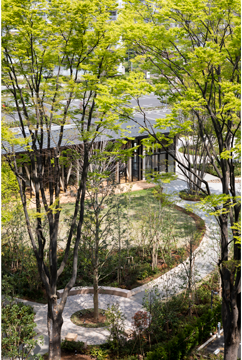


*Amount of CO2 fixed refers to the amount of atmospheric CO2 absorbed and accumulated by trees during photosynthesis as they grow.
This reduces the amount of atmospheric CO2 and helps to prevent global warming.
Biodiversity conservation activities
Conservation Activities
The Haseko Group conducted the following biodiversity conservation activities.
*In
FY2020 and FY2021, many activities were suspended due to COVID-19.
| Dates | Region | Description of activities | Number of participants |
|---|---|---|---|
| Activities in fiscal 2021 | |||
| Nov.27(Sat.) | Tokyo | ”Ikimono Hakken in Tamatsurumaki”(Biodiversity Seminar) | 15(including9children) |
| Activities in fiscal 2022 | |||
| May.21(Sat.) | Tokyo | TOKYO GREEN SHIP ACTION Hachioji Takiyama satoyama preservation activities | 27(No child participant) |
| May.28(Sat.) | Tokai | Fujimae-higata Cleaning Mission in Spring | 11(No child participant) |
| Jun.4(Sat.) | Kansai | Third“Haseko no Mori(Shirahama)”afforestation activities | 18(No child participant) |
| Jun.11(Sat.) | Tokyo | ”Ikimono Hakken in Tamatsurumaki”(Biodiversity Seminar) | 20(including11children) |
| Oct.1(Sat.) | Tokyo | TOKYO GREEN SHIP ACTION Kiyose Matsuyama Green Area preservation activities | 22(No child participant) |
| Oct.15(Sat.) | Tokyo | Sixth “Haseko no Mori(Tateshina)”afforestation activities | 29(No child participant) |
| Oct.22(Sat.) | Tokai | Fujimae-higata Cleaning Mission in Fall | 16(No child participant) |
| Nov.12(Sat.) | Kansai | Kyosei no Mori tree-planting activities | 25(No child participant) |
| Nov.22(Sat.) | Tokyo | “Ikimono Hakken in Tamatsurumaki”(Biodiversity Seminar) | 19(including10children) |
| Activities in fiscal 2023 | |||
| May.22(Sat.) | Tokai | Fujimae-higata Cleaning Mission in Spring | 14(No child participant) |
| May.27(Sat.) | Kansai | Fourth“Haseko no Mori(Shirahama)”afforestation activities | 47(including6children) |
| Jun.10(Sat.) | Tokyo | “Ikimono Hakken in Tamatsurumaki”(Biodiversity Seminar) | 25(including13children) |
| Oct.14(Sat.) | Tokyo | Seventh “Haseko no Mori(Tateshina)”afforestation activities | 78(including5children) |
| Nov.11(Sat.) | Tokyo | TOKYO GREEN SHIP ACTION Kiyose Matsuyama Green Area preservation activities | 43(including4children) |
| Nov.25(Sat.) | Kansai | Biodiversity Conservation Activities in Asuka Village | 32(No child participant) |
| Activities in fiscal 2024 | |||
| May.25(Sat.) | Tokai | Fujimae-higata Cleaning Mission in Spring | 27(No child participant) |
| May.25(Sat.) | Kansai | Fifth“Haseko no Mori(Shirahama)”afforestation activities | 53(including4children) |
| Oct.5(Sat.) | Tokyo | “Ikimono Hakken in Tamatsurumaki”(Biodiversity Seminar) | 14(including7children) |
- Sustainability TOP
- Message from the Management
- Message from the Officer in Charge of Sustainability Promotion
- Haseko Group's Sustainability Management
- Climate Change Response
- The Digital Transformation Strategy of the Haseko Group
- D&I at the Haseko Group
- Creating attractive living spaces
- Building a company worth working at
- Protecting the precious environment
- Nurturing a culture of trust
- ESG Data and Disclosures
- External Evaluations and Awards
- Integrated Report
- Philosophy and Policies
- Special feature archives




